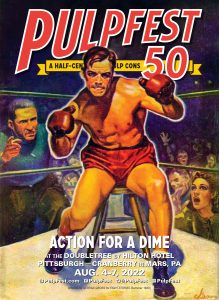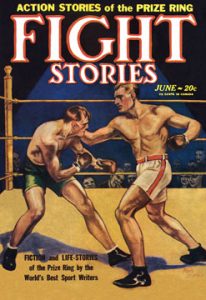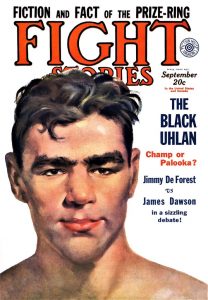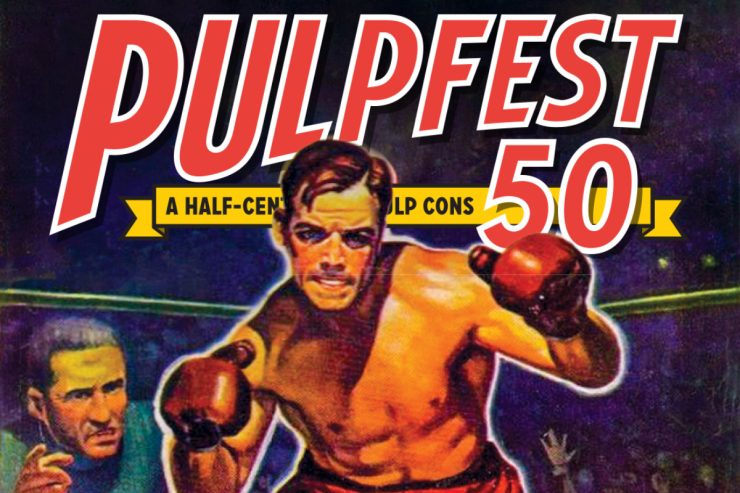Fifty years ago, there were no organized gatherings specifically geared toward pulp fiction and the magazines in which it appeared. That all changed when Ed Kessell, Earl Kussman, and Nils Hardin founded Pulpcon in 1972. This year we salute the fiftieth anniversary of that first pulp con — the convention now called PulpFest.
 The question “Why PulpFest?” inevitably elicits either bittersweet memories from longtime attendees or a personal testimony explaining why the contributors identify as part of the pulp community.
The question “Why PulpFest?” inevitably elicits either bittersweet memories from longtime attendees or a personal testimony explaining why the contributors identify as part of the pulp community.
I didn’t discover such a thing as pulp conventions existed until an internet search brought me to PulpFest in Columbus in 2009. The experience was akin to a black & white Kansas door opening into Technicolor Oz.
I have L. Sprague de Camp’s essays in the Lancer/Ace Conan reprints for giving me my first real lesson on pulp magazines during my early adolescence.
A few years later, I was devouring everything I could find by and about Hammett and Chandler and again, pulp magazines littered those same mean streets.
The Cleveland Public Library had a massive illustrated history of science fiction that also expanded my adolescent education about Hugo Gernsback and the influence of Amazing Stories.
I pawed through dozens of Doc Savage and The Shadow paperback reprints at American Book & News in Parma, Ohio, while scouring for scarce Edgar Rice Burroughs and Sax Rohmer titles.
I didn’t really think of pulp fiction as its own medium. Sword & Sorcery in yellowing pages of Weird Tales was a very different beast than Edgar Rice Burroughs’ jungle, interplanetary, and lost world adventures. The hardboiled fiction in Black Mask was a completely different form all its own.
I didn’t think what I loved was Pulp Fiction because I also loved classic horror, German silent films, Golden Age screwball comedies, Silver Age comic books, and more. It all seemed part of this past world that was so much better than the one I lived in. I didn’t know anyone else who shared these interests. Used booksellers would comment on finding it surprising that a young person (when I was young) was interested in buying books they were selling for as little as a quarter.
I knew fandom. Comic books and magazines like Famous Monsters of Filmland and Starlog covered sci-fi and horror conventions. I attended a couple of Doctor Who conventions, but I had no idea that there was a following for pulps, let alone an organized fandom.
My personal pulp fandom debt rests with internet search engines and Wold Newton scholarship. Reconnecting with names from my childhood like Will Murray and Don Glut proved I was on the right path. Learning of shadowy scholars with exotic names like Win Scott Eckert and Rick Lai proved revelatory. Learning that a pulp convention was as close as Columbus, Ohio convinced me to make the trek.
What I found at PulpFest was nothing like the comic cons or sci-fi cons or horror cons that I had attended. These were, by and large, friendly people who quickly made me feel at home. Even when I was surrounded by unfamiliar faces who didn’t really speak to me, I saw their camaraderie and knew I had found a place where I belonged.
That’s what PulpFest really is, it’s home.
PulpFest is a place where name badges revealed larger-than-life figures like Will Murray, Charles Edward Pogue, and David C. Smith had faces and personalities and weren’t simply bylines from my past. These titans were making the pilgrimage to Mecca alongside me.
PulpFest is a place where I discovered Win Scott Eckert didn’t speak in clipped German tones and Rick Lai wasn’t the diabolical Eastern mastermind I had hoped. Instead, both gentlemen proved to be kindred spirits who quickly became genuine friends to someone who counted very few people in the real world as friends.
PulpFest is a place where new names to me like Ron Fortier & Rob Davis and Mike Chomko & Jack Cullers and Ed Hulse & Gene Christie quickly welcomed me into their fold as a prodigal son who was no longer lost.
There is no place like home. PulpFest is the home I had been busy constructing since childhood that I was surprised to discover amounted to more than my dreams of a yesterday that was gone long before I was born.
Thank you, PulpFest, and all of my pulp family. You brought true joy to my life and gave me my first real sense of belonging.
I am not a social person, but I’ve tried to bring the same spirit of PulpFest to everyone I meet at a pulp con. All are welcome, all belong. All have a place at the banquet table.
Since its inception, Pulp has served up something for every taste. Nearly a century after its peak, we the faithful few are still delighting in the latest excavated treasure or marveling at that vibrant and vivid reproduction that captures all of the charm of the original, but can never match the exquisite aroma or crisp feel of the genuine article.
We are one community united by Pulp.
Thank you, PulpFest, for giving us a place to gather together and share our passions.
William Patrick Maynard is the licensed continuation author for the Sax Rohmer Literary Estate. His short fiction has been published in anthologies by Airship 27, Bold Venture Press, Black Coat Press, Edge Publishing, Flinch Books, MX Books, Riviere Blanche, and Titan Books. He has authored over 250 articles for numerous magazines and websites. He has contributed Blu-ray commentary tracks and produced bonus features for releases by MGM, Shout Factory, Kino Lorber, and The Serial Squadron. Bill is on the editorial board of The Battered Silicon Dispatch Box and is a member of the PulpFest Organizing Committee where he serves as Assistant Director of Marketing and Afternoon Programming Director. He resides in Northeast Ohio where he is celebrated as a former welterweight boxing champion.
We hope you’ll join us to celebrate “A Half-Century of Pulp Cons” at PulpFest 50. It will take place from August 4 – 7 at the DoubleTree by Hilton Hotel Pittsburgh – Cranberry in Mars, PA. You can become a member of the convention by clicking the Registration button on our website. If you need lodging, you can also book a room on our site.
Our postcard image has been adapted by PulpFest advertising director William Lampkin from George Gross’s cover for the Summer 1940 issue of the Fiction House pulp, Fight Stories.
With the growth of America’s magazine, motion picture, newspaper, and radio industries during the teens and 1920s came a corresponding increase in the popularity of organized sports. According to 1920s Fashion & Music: The Life & Death of the Roaring Twenties:
“From the Black Sox scandal of 1919, the historic home runs records of Babe Ruth, player Red Grange and coach Knute Rockne’s domination in football, Jack Dempsey’s vicious knock-outs, and Man o’War’s brilliant races, the sports of the 1920s have become legendary to fans around the world.”
 Fiction House publishers John Glenister and Jack Kelly were always more than willing to jump on the latest bandwagon. Big-time boxing fans themselves, Glenister and Kelly launched Fight Stories in mid-1928. The first specialized sports pulp magazine, it debuted with its June number — featuring cover art by Abell Sturges — and ran for 106 issues before it went down for the count in Spring 1952.
Fiction House publishers John Glenister and Jack Kelly were always more than willing to jump on the latest bandwagon. Big-time boxing fans themselves, Glenister and Kelly launched Fight Stories in mid-1928. The first specialized sports pulp magazine, it debuted with its June number — featuring cover art by Abell Sturges — and ran for 106 issues before it went down for the count in Spring 1952.
Initially edited by William H. Kofoed, the first issue of Fight Stories promised stories “bright with the courage of he-men in a he-men’s game. . . . a rallying place for men of your kidney. . . . Youth and experience will blend to give you . . . a CLEAN, PACKED-WITH-ACTION, ENTERTAINING magazine.”
Fight Stories promised its readers, “. . . the best sports writers of your day” spinning “yarns of romance and action and adventure of the prize ring.”
The magazine kept its word, employing leading aviation author George Bruce, the wide-ranging Arthur J. Burks — who refereed many boxing matches during his Marine Corps career — Fiction House editor Jack Byrne, and the talented and prolific William R. Cox, Eugene Cunningham, T. W. Ford, and Theodore Roscoe to spin various tales of fisticuffs. In 1929, Robert E. Howard — best known for his sword and sorcery tales of Conan — began contributing his Sailor Steve Costigan yarns to both Fight Stories and its Fiction House companion, Action Stories. The amateur boxer and fan of the sport contributed seventeen Sailor Steve stories to the two magazines over the next three years.
 Popular sportswriter and columnist, Jack Kofoed, added to the mix by contributing biographies of countless boxers as well as articles including “The Ten Greatest Fights of All Time.” Kofoed continued to contribute long after his twin brother William’s departure as editor in 1932.
Popular sportswriter and columnist, Jack Kofoed, added to the mix by contributing biographies of countless boxers as well as articles including “The Ten Greatest Fights of All Time.” Kofoed continued to contribute long after his twin brother William’s departure as editor in 1932.
Over its twenty-four-year run — including a hiatus from 1932 to 1936 — Fight Stories delivered what it promised: “FICTION and FACT of the RING.” However, we must admit that unlike Jack Dempsey — pictured on Erle K. Bergey’s cover for the September 1930 Fight Stories — Bill Maynard was never a boxing champion. That idea is no more true than your typical pulp magazine author biography. Regardless, watch out for Bill’s left hook.
Join pulpfest.com on April 25 when Madeleine “Mac” Gagné, a member of Freshly Squeezed Pulp answers the question, “Why PulpFest?”






